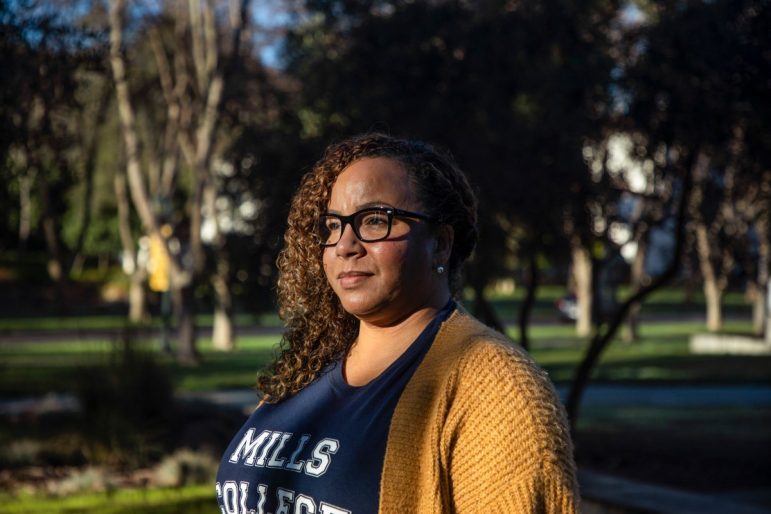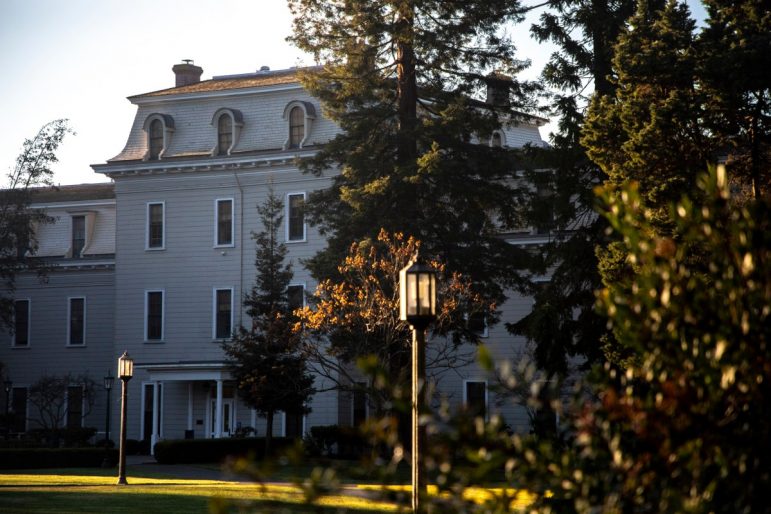When Jenny Varner was a child, her mother used to share fond memories of her time at Mills College, an all-women’s college in Oakland. Her mother would vividly describe the historic buildings on campus and the courses she took in the book arts program in the 1990s.
Those stories, plus the school’s art history program, made Varner certain that Mills was the school for her. When it was time to apply for colleges, she only applied there. But that life-long dream came to an end after Varner finished sophomore year. In September, Mills announced it would merge with Northeastern University, a much larger, co-ed school based in Boston.
Varner decided to leave Mills — she couldn’t stomach staying at a school that would feel so different. The merger is set to be made final in June.
The 170-year-old college isn’t “going to be Mills” anymore after the merger, Varner said. “It’s just different to be surrounded exclusively, pretty much, by women and non binary students. It’s empowering. And it starts to mean something.”
The merger is the latest illustration of challenges that women’s colleges have weathered. Fifty years ago, the United States had 230 women’s colleges. Now, fewer than 40 remain, according to the Women’s College Coalition.
The shrinking number is a sign of shifts to co-ed campuses and the financial pressure that many small, private colleges have faced over the years and seen worsen recently.
The Mills-Northeastern merger is an example of the route some private colleges have taken to avoid closure. More such mergers are expected, experts say. Also in the works: Marymount California University is working to secure approval to merge with Florida-based Saint Leo University, and the San Francisco Art Institute this month announced plans to become part of The University of San Francisco.
These arrangements can help colleges survive, but they also come with costs. Mills alumni and current students who spoke to the CalMatters College Journalism Network said they’re concerned the merger and the arrival of male students will change the tight-knit campus. The Alumnae Association of Mills College sued the college in the summer of 2021 arguing they were deprived of financial information about the future of Mills, but agreed to drop the lawsuit Jan. 12.
The changes at Mills will be stark.
This semester, male undergraduates have started arriving on campus for the first time since Mills opened as The Young Ladies Seminary in 1852. Northeastern University will be the name on all degrees awarded after June 30. Northeastern students will make up about half of the projected 1,000 students on the Mills campus next school year. And some Mills majors, such as Women’s Studies, may be eliminated.
The shifts are just the latest that Mills has navigated in recent decades.
Mills became the first women’s college to offer a computer science major in 1974. About 15 years later, it would reverse a plan to become co-ed. In 2014, it was the first women’s college in the United States to adopt an admissions policy that embraced trans women.
Mills College President Elizabeth Hillman told CalMatters the merger was a solution to financial challenges the college faced prior to the pandemic, which became more urgent once pandemic-induced enrollment declines hit. And Northeastern President Joseph E. Aoun said in a statement announcing the deal that it is a chance to create something “truly unique” — a bicoastal university that builds on the complementary strengths of the two institutions.

But the news was jarring to students like Varner. She applied to transfer to Lewis and Clark College in Oregon and is waiting to hear if she got in. She knew leaving Mills was the right choice after nobody could tell her about the future of her program.
“Even the professors can’t tell us what my senior year is going to look like,” she said.
Sophomore Naydelin Sanchez, who is majoring in ethnic studies and planning to graduate in 2023, initially felt relieved by news of the merger. It meant Mills wasn’t going to go under. But as time went on she realized her degree might be in jeopardy.
Now, she said she feels lied to and “played by a system.”
Northeastern doesn’t offer an ethnic studies major. A preliminary document on the Mills website listing comparable Northeastern majors includes “Africana Studies” and “Politics, Philosophy, and Economics.”
Sanchez said so far nobody has told her how to proceed. She hasn’t met with an adviser since she registered for classes. She doesn’t know if classes she’s taking for an ethnic studies major will end up counting toward her degree.
“I don’t even know who to complain to because literally they’re just like, ‘Here’s this information and deal with it, but we still don’t have an answer to how to fix your issues,’ ” she said.
Now, she isn’t sure whether she will stay at Mills or transfer out.
When asked to comment on Sanchez’s situation, a Mills spokeswoman said, “I’ve been asked to advise you that it is early in the merger process,” and deferred to online FAQs about the merger.
Officials will spend the coming year shaping the full slate of undergraduate and graduate academic programs, the FAQs say.
Ethnic studies isn’t the only major seemingly slated for a change, according to the preliminary document.
Mills offers a “Women’s, Gender, and Sexuality Studies” major, while Northeastern has only a “History, Culture, and Law” degree and a gender/sexuality concentration.
Those differences in curriculum matter, critics of the merger say, because they reflect the culture and values at Mills, where the majority of students are people of color and many say it is a safe space for LGBTQ people.
Shay Franco-Clausen, a public policy senior at Mills who identifies as Black, Afro-Latina, and lesbian, said she chose a women’s college to feel more comfortable sharing ideas without judgment or being spoken over.
“That was the main purpose of our little place in the world — to grow academically, build partnerships with other women who identified similar to us, who had the same values, to do amazing things in the community together. Now, I’m not saying that men can’t do the thing, but that’s not what I applied to,” she said.

Bay Area-raised Franco-Clausen serves on the board of the Santa Clara Valley Open Space Authority, a conservation-focused special district in the state. Franco-Clausen was initially drawn to the rich history of women’s advocacy at Mills, as well as its alumni network of radical and community-focused activists and elected officials such as Rep. Barbara Lee, a Democrat representing northwest Alameda County.
After the merger, Franco-Clausen fears Mills will “be another place that’s gentrified with people from all over that may not contribute to the fiber of Oakland or the East Bay.”
She is now racing to finish 21 credits before May, taking six classes at Mills and one class at West Valley College, a community college. If she can’t finish in time, she’ll have to take classes under the Northeastern umbrella next fall — a non-starter, she said.
Mills and Northeastern officials say they are committed to helping current Mills students who won’t graduate this year still complete their degree. They also want to bridge the gap between the two institutions.
Continuing Mills students will see Northeastern’s higher tuition rate offset with scholarships and financial aid. Those who need eight credits or fewer to complete their degree can do so in a special six-week term this summer. Students who are farther away can finish their degree through Northeastern, or transfer to one of 14 schools covered by a partnership agreement. Those schools include University of the Pacific, Mount St. Mary’s University, and Santa Clara University.
Ajuan Mance, an ethnic studies and English professor at Mills College specializing in African American literature, will usher in the new era at Mills this semester. Mance is teaching a special course on social change to about 20 students, with roughly half from Northeastern.
It’s part of the Leading Social Change program, meant to build relationships between faculty, staff, and students at both schools.
Mance said her class will focus on some of the major social movements in history, and the leadership styles that helped them succeed. The class creates an opportunity to really focus on creating a classroom that feels inclusive for everyone — regardless of gender, ethnicity, neurodiversity, or physical ability, she said.
“What I am interested in doing is having students maintain an awareness of all of the ways in which they could be experienced as privileged and silencing by others. And by the same token, having students who experience themselves as marginalized engage in and step into their entitlement to have a voice just like everyone else,” she said.
Mance said “throwing gender in the mix in terms of having cis-gender men is simply just another dimension of the diversity that we have” at Mills.
The merger also includes the creation of the Mills Institute, a research center focused on gender and racial justice.

“I think the Northeastern opportunity is a truly extraordinary one, to bring tremendous resources and inspiration to the Bay Area, and to enable Mills to expand its mission, not just sustain its mission,” Hillman, the Mills president, said.
She added that while a merger was right for Mills, every women’s college is different — depending on their circumstances, students, region, and programs.
Mills has been grappling with a multimillion-dollar deficit for many years, in addition to student enrollment dropping by roughly 30% over the last five years, a spokeswoman said.
The pandemic accelerated the college’s financial problems. In a July 2020 message to the Mills community, Hillman said the college was projecting a $14 million loss for the upcoming fiscal year.
The tensions apparent in the Mills-Northeastern merger illustrate just how sensitive these partnerships can be, said Brian Weinblatt, the founder of Higher Ed Consolidation Solutions, a merger consultancy.
“This isn’t just a transaction on paper, where it’s like, ‘Oh, we’re just doing an agreement, we’re signing it and moving it forward,” he said. “Colleges and universities are living breathing organisms of human beings.”
And more mergers are likely across the country in the coming years, experts on women’s colleges and mergers in higher education said.
Before the pandemic, Carleton College economics professor Nathan D. Grawe estimated that the nation’s falling birthrate meant the college-going population would decline by 15% between 2025 and 2029. The Northeast, where many colleges and universities are located, was to be hardest-hit, according to his projections.
“The pandemic and the demographic cliff has intensified the forces that have been at work for 10 or 20 years before that,” said Richard Ekman, president of the Council of Independent Colleges. “All the more reason to merge.”
The outlook is a bit different in California, where its public university system is booming, buoyed by growing numbers of college-ready high schoolers and students seeking to transfer out of the community college system.
The number of high school graduates who meet requirements for the University of California or California State University System increased 7% — more than 14,000 students — from 2016-17 to 2020-21, according to state data.
The Cal State system enrolled its largest-ever student body in fall 2020. In the UC system, freshman enrollment has increased by about 4% on average for the last two decades, according to the UC Accountability Report.
The capacity crunch in California’s public universities has lured out-of-state colleges eager to boost enrollment with students from the Golden State.
A Northeastern spokeswoman declined to comment on whether booming enrollment numbers in California played a role in Northeastern’s decision to merge with Mills.
The Mills merger will expand the Boston-based university’s West Coast footprint. Northeastern already has campuses in San Francisco, Silicon Valley, and Seattle.
Women’s colleges have unique challenges of their own, experts said.
They have faced years of underfunding, leading to campuses that need major facilities upgrades, said Emerald Archer, executive director of the Women’s College Coalition. Archer is also the founding director of the Center for the Advancement of Women at Mount Saint Mary’s University in Los Angeles.
Students at women’s colleges are also more likely to be women of color and come from families with limited financial resources, compared to students at other liberal arts colleges, according to a study sponsored by the Women’s College Coalition.
That means women’s colleges often must be generous with the financial aid packages they offer, according to several academics studying women’s colleges and higher education.
Full-time, first-time undergraduates at women’s colleges are significantly more likely to have been awarded a Pell grant compared to students at liberal arts colleges — 43.2% compared to 32.6%, according to the WCC study. Pell Grants are the federal government’s main financial aid grant, distributed to undergraduate students below a specific income threshold.
At Mills, about one third of students received Pell grants in 2021, and 89% of all undergraduates received some form of financial aid that year.
“I don’t foresee that women’s colleges will go away entirely,” said Susan Marine, a professor at Merrimack College who studies higher education and feminist and LGBTQ issues. “I think it’s going to largely depend on their creativity and resourcefulness.”
The situation is different at selective women’s colleges such as Scripps, which admitted about one-third of applicants in 2020 and is part of the seven Claremont Colleges.
The market value of Scripps’s endowment was $374.8 million in fiscal year 2020 compared with $187.3 million for Mills College, according to data from the National Association of College and University Business Officers.
“The elite, liberal arts colleges are still doing okay, and they’re not going to go anyplace. But it’s other ones that have less name recognition, lower endowments, cannot make the affordability case, those are going to be ones that are going to be struggling,” said Gretchen Edwalds-Gilbert, acting vice president of academic affairs and professor at Scripps College.
The future of women’s colleges has also drawn the attention of members of Congress.
The House Appropriations Committee directed the Department of Education to include information on the challenges facing women’s colleges, and how federal resources could be used to shore them up, in its next Congressional budget request. The provision is in a report accompanying a federal appropriations bill that passed the House over the summer but has since stalled.
Without more support, some graduates of women’s colleges fear the loss of what they describe as a unique educational experience.
Hannah Bluhm, a 2000 alumna of Mills who opposed the merger, said she wishes that Mills had merged with another women’s college. She felt safe at Mills, she said, and emboldened to take risks.
“I accidentally took a computer programming class when I was a freshman, and we didn’t have a computer growing up,” she said. ”But my professor was a woman and all my classmates were women, and I didn’t feel intimidated, I didn’t drop the class. And I know that I would have if I was at a co-ed school.”
Doshi is a former fellow with the CalMatters College Journalism Network, a collaboration between CalMatters and student journalists from across California. This story and other higher education coverage are supported by the College Futures Foundation.
